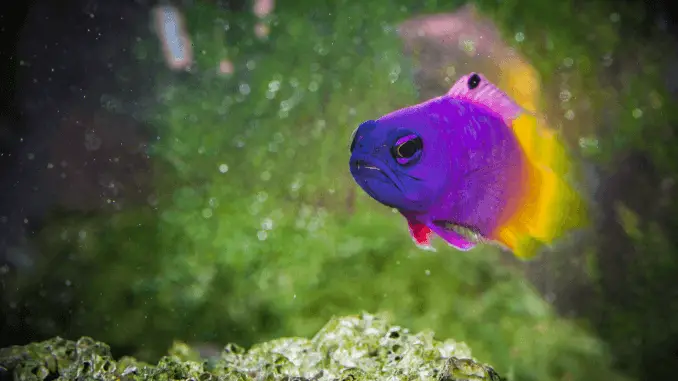
The Royal Gramma fish, also known as a Fairy Basslet or Gramma loreto, is a small, vibrantly colored fish native to the Caribbean.
It is a hardy, peaceful fish that would be perfect for both beginner fish keepers and experts alike.
Often the crown in an individual’s collection, this fish makes the perfect addition to most saltwater aquariums.
In this article we are going to cover everything you need to know about keeping the Royal Gramma including its: dietary needs, typical behavior, required tank conditions and compatibility with other species.
However, before we begin, I’ve included a quick facts table below for anyone looking for a summary.
TABLE OF CONTENTS
Royal Gramma Facts & Overview
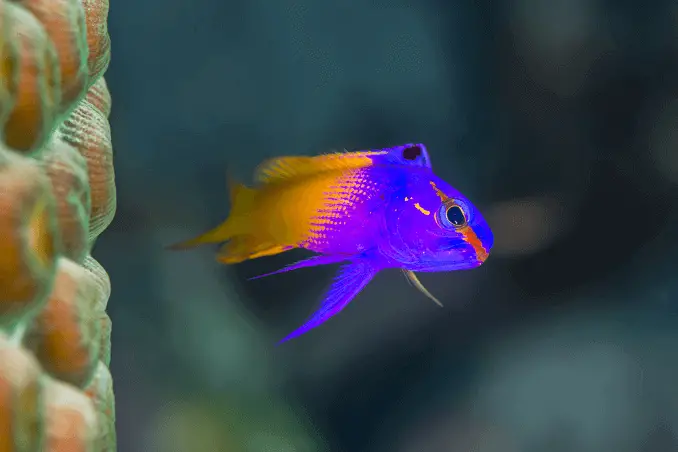
| Category | Rating |
| Care Level: | Easy |
| Temperament: | Peaceful |
| Color Form: | Purple, yellow |
| Lifespan: | Over 5 years |
| Size: | Up to 3 inches |
| Diet: | Carnivore |
| Family: | Grammidae |
| Minimum Tank Size: | 30 gallons |
| Tank Set-Up: | Marine: coral or rocks, and plants |
| Compatibility: | Reef safe |
The Royal Gramma is a beginner friendly, low maintenance, and peaceful saltwater fish that would provide exceptional color to any aquarium it is placed in, with its vibrant purple and yellow body.
It is a reef compatible, easy to care for, fish which is generally considered a must have for most aquarists.
They can be purchased for around $20 (depending on their size) and are an entertaining fish to observe.
Another reason why Royal Grammas are favored by beginners is because they are hardy and resistant to a lot of common disease.
It’s a fish you can’t really go wrong with. They are also friendly with lots of other species and make a great community fish. Your tank should be at least 30 gallons and contain lots of rockwork and caves for them to hide in- this helps them to feel secure. However, as they are used to deep-water the tank shouldn’t be exposed to any harsh lighting.
Generally with beginners, this fish should be kept as a single specimen and you should expect it to live to at least 5 years old.
Appearance
The Royal Gramma is often the crowning glory of any aquarium it is placed in due to its vibrant coloring; the front half of the fish is characterized by a vibrant iridescent purple or violet that blends into a golden yellow towards the tail.
The middle of the fish, where the two colors blend, generally has a series of dots which gives each Royal Gramma a different pattern.
You will also notice a thin black line that extends from the mouth up through the eyes and a small black spot on their dorsal fin.
The Royal Gramma is a small fish and you should expect yours to grow to around 3 inches in size. The largest captive bred Royal Gramma was measured to be 3.1 inches.
Identifying the gender at birth is not possible as all Grammas are born females. However in a shoal the most dominate group member will change sex and turn into a male. The male will grow larger than the females and the ventral fins will also be larger.
In addition to this, males generally have more vibrant colors than the females.
The Royal Gramma is often confused with the Royal Dottyback (Pictichromis paccagnellae). Whilst the Royal Dottyback looks similar, it is a very aggressive fish and has a low compatibility with most other species- generally it should be avoided for beginners.
The easiest way to tell the difference between a Royal Gramma and a Royal Dottyback is to look at the coloring on the body.
On the Royal Dottyback there is no blending between the purple and yellow. Whereas, on the Royal Gramma you will notice the purple fades into the yellow. Also, the Royal Dottyback has clear fins.
Typical Behavior
The Royal Gramma is generally a calm, somewhat shy, and passive fish from who you should not expect any problems. The only exception to this is territorial problems. As previously mentioned, they like to claim rockwork and crevices as their home. When other fish intrude on their home they will become territorial and chase them away.
They will generally stay near their chosen home and if frightened they will return to their home quickly.
In terms of jumping, they are a notorious jumper. So any aquarium they are placed in must have a good weighted lid to stop them jumping out of the tank. They are most likely to jump when they are new to the aquarium.
For any unique behavior, they seem to face their stomach towards nearby hard surfaces which results in the strange ability to hang and swim upside down when underneath ledges. This is no cause for concern however and many beginners often confuse this behavior with an illness.
Habitat and Tank Requirements
The Royal Gramma is a saltwater fish found in the deep-water reefs in the Western Atlantic (Caribbean).
This particular fish is at home when surrounded by vast rockwork such as reefs, coral outcroppings, caves and overhangs in dull lighting.
They make this rockwork their home and don’t venture far out, as they aren’t exceptional swimmers. You will see them hiding within the rockwork waiting for a food particle to float by which they can eat, before quickly swimming home.
It will typically be found at a depth of 2-60 meters and is best known for swimming upside down under ledges and in caves.
As for keeping Royal Grammas in aquariums, the minimum tank size you should use is 30 gallons. If you intend to keep them in pairs then you should have at least a 50-gallon tank. Finally, if you intend to keep a group, a tank size of 100+ gallons is needed.
Now, for the conditions of the tank.
Tank Conditions
The perfect water temperature for them is anywhere from 72°F to 78°F. pH levels should be kept within 8.1 and 8.4, with a carbonate hardness (dKH) of 8-12° and a specific gravity of 1.020-1.025.
Tank-Tip
Also, the tank should not be exposed to any sharp/harsh light.
As previously mentioned, in their natural environment, Royal Gramma will be found in deep-water reefs. So you should ensure your tank has lots of live rock, cavities and caves for them to retreat and hide in, as this is where they will spend most of their time.
Compatibility with other Fish
The Royal Gramma is a peaceful fish that would make a fantastic addition to most saltwater aquariums.
As a Basslet, in general they will be fine with: Angles, Boxfish, Clownfish, Filefish, Gobies, Jawfish, Hawkfish, Rabbitfish, Squirrelfish, Corals and Invertebrates.
As a peaceful, generally passive fish, they can coexist with a large variety of species providing these four key criteria are met:
- The other fish species must not be aggressive themselves.
- They should not appear visually similar to the Royal Gramma – particularly the bright purple color.
- They certainly should not try to poke around the Gramma’s chosen hiding spot.
- Finally, they should not be much larger, or a predatory fish that is capable of eating the Royal Gramma (e.g. Lionfish, Eels and Snappers).
Providing you meet these four criteria you are set.
Whilst they are peaceful in nature they do have an interesting quirk. As mentioned in the habitat section, they love surrounding themselves by vast rockwork.
They can be territorial and will become aggressive and chase fish away when they encroach on their favorite caves and crevices. This is not to be confused with bullying though, bullies they are not. They are just possessive of the rockwork they call home.
For this reason you should make sure your aquarium has lots of rockwork and hiding places if you plan to keep Royal Grammas.
If they become aggressive though, you will see the notorious Royal Gramma ‘gape’. During this gape the Gramma will open its jaws as wide as possible to give the comical appearance of a Great White Shark!
Keeping Royal Grammas Together
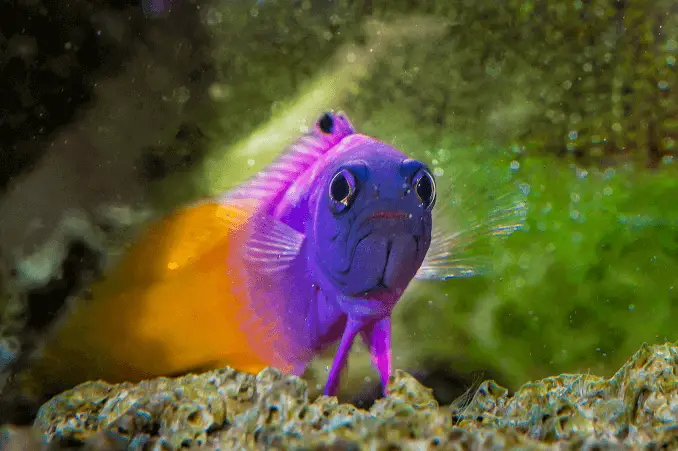 Generally most experts recommend that the Royal Gramma should be kept as a single specimen. This is because they can be territorial and without enough rockwork and hiding places, they will continually fight each other for this territory.
Generally most experts recommend that the Royal Gramma should be kept as a single specimen. This is because they can be territorial and without enough rockwork and hiding places, they will continually fight each other for this territory.
So, if you are going to have a pair, remember to make sure your tank is at least 50 gallons and has plenty of rockwork and crevices so each Gramma can have its own space.
The pair should also be a male-female pairing.
If you are daring, there are success stories of keeping a harem of Grammas in a tank.
To achieve this you must introduce all of them to the tank at the same time and have no existing Royals in the tank. Furthermore, the tank should be at least 100 gallons and have lots of rockwork.
One final tip for a harem: when choosing your group of Grammas be sure to obtain the smaller specimens; generally the smaller specimens are females.
Diet
In its natural habitat the Royal Gramma is primarily a planktivore that eats zooplankton and phytoplankton. It is known as a cleaner fish, which means it will also eat the parasites off of the skin of other fish.
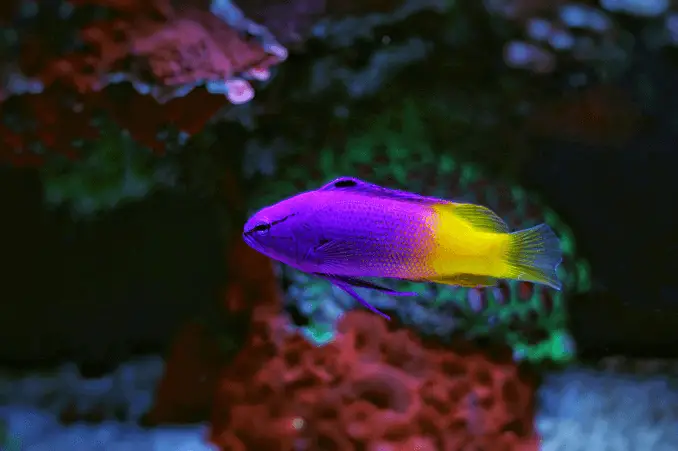 However when kept in an aquarium, it can and will eat small meaty foods such as: brine and mysis shrimp.
However when kept in an aquarium, it can and will eat small meaty foods such as: brine and mysis shrimp.
In an aquarium setting it will also adjust to eat dead food such as: crustaceans and fish flesh.
With your Royal Gramma, you should aim to feed it a varied diet including: plankton, crustacean flesh, mysid, brine shrimp, and other quality frozen meaty preparations.
With captive bred Royals you can also rely on prepared flake and pellet foods- however make sure to mix it up by rotating what you feed them. This will prevent your fish from becoming adjusted to eating only flakes and pellets. This is especially true with newly acquired specimens.
In terms of feeding, the Royal Gramma is one of the easiest fish to feed. You will be hard pushed to find one that’s a fussy eater!
You should aim to feed them several times throughout the day. Again though, they aren’t fussy eaters so will tolerate alternative feeding cycles (e.g. single daily feed cycles) as well.
You will notice they prefer to eat from the middle of the water column and generally they will rush out from their hiding place to grab anything edible that drifts close by.
Breeding
Unlike many other saltwater fish, the Royal Gramma is very easy to breed in captivity.
The breeding activity starts with the male building a nest using small rocks and algae. The female will then deposit anywhere from 5-40 eggs into the nest. The male can then release his sperm to fertilize the eggs. This normally occurs late spring/early summer in the wild.
During the breeding season this routine will happen daily for a month.
The eggs will ‘stick’ to the algae for the next 5-7 days until they hatch. You will find they generally hatch during the evening; when it’s dark.
As they hatch in a sequence, and by such small numbers, the biggest problem with raising Royal Grammas is feeding them. This is because you will find a large difference in the size of their mouths. So growing out these fish can be problematic. It’s best to feed them copepods and rotifers until they reach a Fry.
When they develop into a Fry you can feed them newly hatched brine shrimp.
Is the Royal Gramma Right For Your Aquarium?
The Royal Gramma is a hardy fish that is very easy to care for. They are easy to feed and don’t make many demands.
The only thing you need to account for is adding plenty of rockwork to your aquarium so they have somewhere to hideout.
In general they are compatible with a large variety of other species and are one of a handful of saltwater fish that spawn well whilst in captivity.
As for their cost, they are reasonably price (typically $20) to buy, and very affordable to feed and maintain.
They make the perfect starter fish for a beginner fish keeper, or a great addition to an experienced fish keeper looking to add some color to their tank.
Do you keep Royal Grammas? Let me know your experience with them in the comments below…


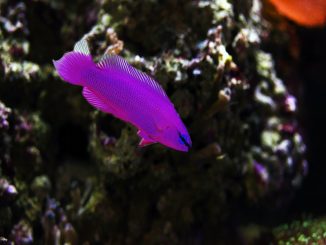
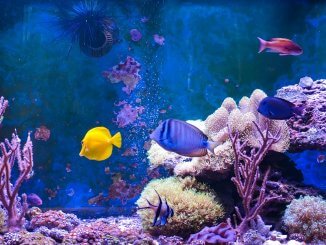

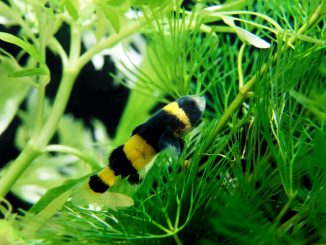
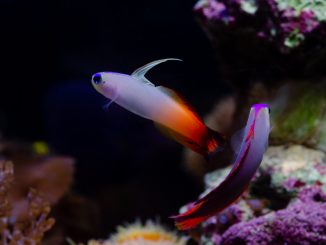
the royal gramma loreto is an amazing fish for any one setting up a matine aquarium
I found this comment in your otherwise excellent treatise about the Royal Gramma a bit mystifying: “Identifying the gender at birth is not possible as all Grammas are born females.” If they’re all born females, then they’re all females at birth. I realize that what you’re trying to say is that you can’t predict, at birth, which one may become the dominate fish and transition to male, but still, words are words and this phrase needs working.
Thanks Jim! Appreciate the feedback, Robert
I had three Royal grammas in a quarantine tank for several months. I added three more, everyone went into hiding, and the new ones were killed overnight.
i have one in my tank its a 3harf foot long
and 200ltr
its a mixture of fish but i noted the gramartends to bully other fish i resentlypit a pyjama cardinal fish in the tank and it chasing it around the tank.gaping at it.